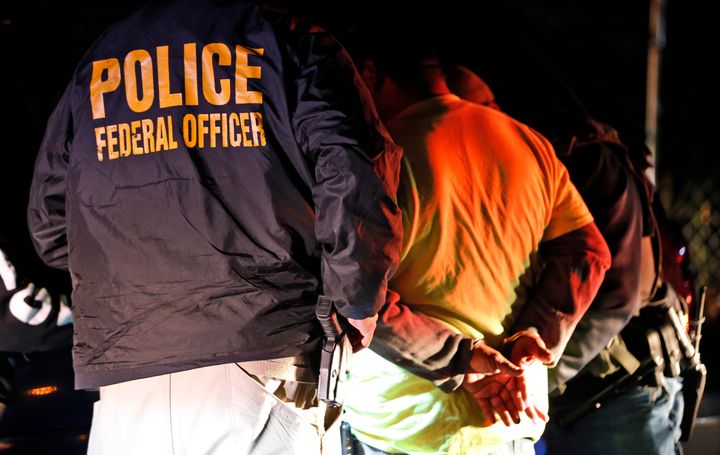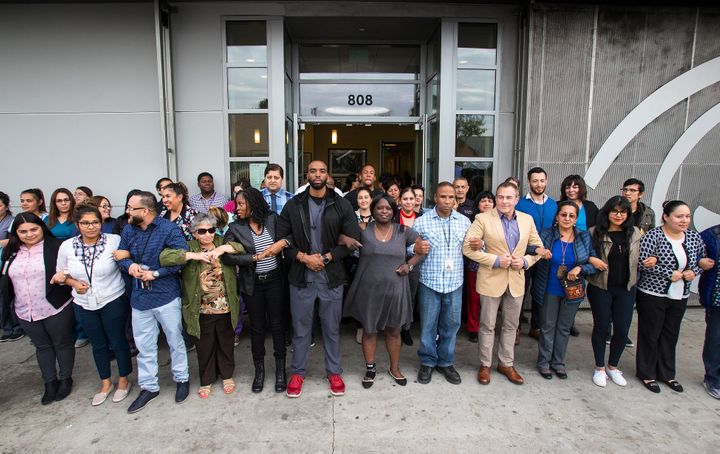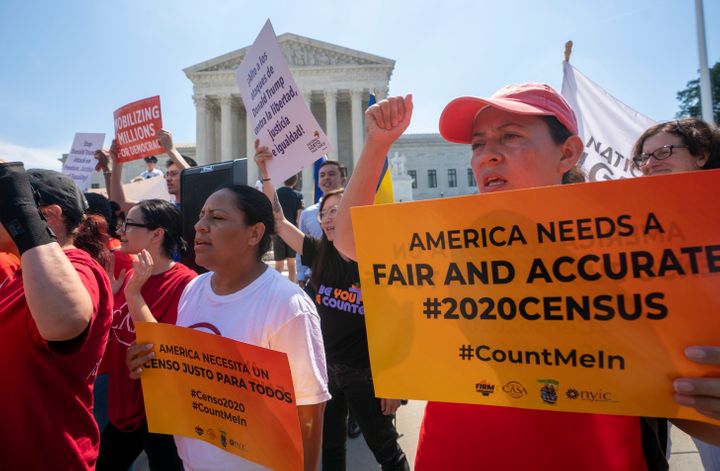[ad_1]
The Trump administration’s effort to add a citizenship question on the 2020 census was thwarted by the Supreme Court in late June. Its end came more conclusively two weeks later when President Donald Trump begrudgingly accepted the ruling. But advocates fear the president’s loud push will still lead to an undercount of immigrants next year.
Another anti-immigrant initiative ― to tighten restrictions on those who can obtain green cards and visas based in part on their use of social services ― could be made official within days. But the proposed change to the so-called “public charge” rule has been scaring immigrants away from accessing government services for months now.
Though Trump has followed through on many similarly harsh anti-immigrant plans, others remain simply threats. But dispersed through proposals, tweets, public provocations, leaks and the media, those unrealized proposals have already had dramatic consequences.
At St. John’s Well Child and Family Center in Los Angeles, patients have begun asking for extra copies of their medical records and additional bottles of medication. They’re moving; they’re disconnecting their phones.
The center, one of the nation’s largest providers of health care to undocumented immigrants, has seen about a 10% drop in visits by those patients over the last few months, according to Jim Mangia, its president and CEO.
“We’re seeing more folks who are going deeper into the shadows,” said Mangia.
In response, the independent nonprofit center launched education and outreach programs to publicize its procedures for protecting patients from Immigration and Customs Enforcement. It saw an uptick in visits. “And then every time there’s a proposal, there’s a drop in visits,” Mangia said.
It’s hard to pinpoint which Trump administration proposals are motivating immigrants to avoid health care, said Dr. Steven Wallace, a professor in the Department of Community Health Sciences at the UCLA Fielding School of Public Health. It’s like trying to figure out “which raindrop got you wet,” he said.
Trump’s announcements of upcoming ICE raids, including ones he doesn’t follow through on, are certainly spreading fear His recent promise that ICE would arrest and deport up 2,000 families led to only 35 arrests. But it prompted many immigrants to stay indoors. At St. John’s, someone came into a clinic lobby in late June and falsely claimed that ICE agents were on the corner outside, Mangia said. About 200 people ran out of the waiting room.

But one of the strongest drivers of fear among immigrants who would otherwise seek care is the plan to change the public charge rule. In September 2018, the Department of Homeland Security laid out a revised rule that would include the use of non-cash government benefits in the list of factors that weigh against immigrants obtaining visas and legal permanent status. Rumors of the stricter rule had already been swirling for months.
It took a year and a half to get from those rumors to a final sign-off by the Office of Management and Budget, which concluded its review process on Wednesday.
But the proposal is already having an effect, just like experts fear the census may have already been tainted. The Trump administration doesn’t need to implement regulations to circumvent Congress and other checks and balances. It is expanding previous margins of presidential power through twisting games of telephone, alarming headlines and hardline messaging coming directly from the White House.
“There is a cynical genius behind this strategy,” said Jackie Vimo, a policy analyst for the National Immigration Law Center, a nonprofit legal advocacy organization.
“The executive order does not have to be implemented,” she said. “The law does not have to be passed. The regulation does not have to be approved. You simply need to get a press story about it.”
If the policy doesn’t need to be in place for it to cause damage, how can opponents fight the consequences?
A Public Fight For ‘Public Charge’
To immigrant rights advocates, the ultimate antidote to messaging seems to be more messaging, confronting fear with fact. But there’s a Catch-22: They want to warn the immigrant community about Trump’s proposals so people can prepare. But they don’t want to spread fear and do his work for him.
“It’s an ethical conundrum that’s impossible to solve,” Vimo said. “Both people who are overstating the harms and those that are providing false assurances could equally be causing harm to families and communities.”
This isn’t to say anti-immigration policies are anywhere close to new. ICE’s deportations this fiscal year — already higher than any other year under Trump — remain lower than in President Barack Obama’s early years. Obama deported more people than any other U.S. president and was called by some critics “the deporter in chief.” There’s always been fear among the immigrant community, said Margarita, an undocumented woman from Los Angeles who’s lived in the U.S. for nearly 25 years. But the difference with this president are the threats.
The public charge proposal would instruct immigration officials to consider participation in government programs like the Supplemental Nutrition Assistance Program (aka food stamps) and Medicaid when granting permanent resident status, meaning immigrants who used those programs would have a more difficult time being approved for a green card. It would not affect people who are already legal permanent residents, refugees or those granted asylum, or U.S. citizen children of immigrants.
To be clear, undocumented immigrants are not allowed to access these federal public benefits. “This whole thing has nothing to do with undocumented immigrants,” said Doug Rand, who worked on immigration policy in the Obama White House and co-founded Boundless Immigration, a technology company that helps immigrants obtain green cards and citizenship. “I mean, they want people to believe it does and get confused about it.”

The rule, whose public benefits change would not be applied retroactively, would still have disastrous results, according to multiple studies and experts, even for those who aren’t directly affected. The Center for American Progress estimates it would apply to an estimated 900,000 immigrants and 176 million nonimmigrants a year.
The proposal could lead to worse health outcomes, especially among breastfeeding women, infants and children; increased poverty rates; and reduced educational attainment, according to the DHS proposal itself. And a study published in JAMA Pediatrics in July estimated that more than 8 million children, most of whom are U.S. citizens presently participating in Medicaid, the Children’s Health Insurance Program or SNAP, are at risk of being unenrolled due to “fear and confusion about the rule, even among immigrant families to which the rule does not technically apply.”
A study released in May by the Urban Institute found that the proposal is already prompting immigrants to unenroll from public services. It reported that 1 in 7 adults in immigrant families said they had avoided non-cash government benefit programs last year in fear of jeopardizing their future green card status.
The study showed that even some families in which every member had a green card or everyone was a naturalized citizen withdrew from public services, though none of them would be affected by the rule change.
Even with the rule expected to be published in the coming days, the preemptive chilling effect will linger. It will take 60 days after it’s published for the rule to go into effect, and that doesn’t account for the litigation expected to follow the release of the rule. Baltimore has already sued Trump over the rule change and Washington state Attorney General Bob Ferguson told HuffPost that his office is “actively preparing for a potential lawsuit.”
Even if the rule is finalized next week, and it’s immediately followed by a series of lawsuits and preliminary injunctions ― even if the Trump administration runs out of time and the rule is never implemented — Rand said, “they still achieve their policy goal because so many people are disenrolling.”
“It’s possible — although it depends on how the election goes, it depends on how the courts go — but it’s possible that this thing never actually gets implemented,” Rand said. “But in the meantime, you’ll have had three or four years of people disenrolling from public benefits they were perfectly entitled to because they were scared.”
Chilling Effect
The last time there was a change in the public charge policy, as part of the 1996 welfare reform package, some immigrants were similarly driven into not applying for government aid, according to the Urban Institute. The legislation appeared to discourage eligible immigrants from accessing health and nutrition benefits, a 1999 report from the institute found. Researchers wrote that the effects stemmed from “confusion on the part of immigrants and providers about who is eligible for benefits and in fears relating to the application of the public charge doctrine” — two factors to which experts attribute the chilling effect today.
In the colonias of South Texas, unincorporated communities with high populations of undocumented immigrants along the U.S.-Mexico border, people are preparing by learning how to grow their own food, said Maria, an undocumented woman who asked to be identified by her first name only because of her immigration status. But in the summer, when temperatures routinely hit 100 degrees, she said nothing can grow. Families have also been purchasing farm animals like chickens to ensure they have a food source. Maria and her daughters have been volunteering at her church’s food pantry to have closer access to the program, which opened after Trump took office in case people left government food programs.
Without access to government food programs for her children, who are U.S. citizens, Maria said she and her husband will have to choose between buying food or school supplies for the kids.

In New York City, there’s been a “significant drop” in the participation of eligible noncitizens in government programs, SNAP in particular, according to Rep. Eliot Engel (D-N.Y.). The city saw a nearly 11% decrease in the enrollment of eligible noncitizens in SNAP from January 2018 to January 2019.
The Community Health and Social Services Center, a Detroit nonprofit that serves a large undocumented population, has seen effects similar to those at St. John’s. Pregnant patients at CHASS often refuse to enroll for supplemental benefits under the Women, Infants, and Children (WIC) program because they fear the government will use the information to track them down, according to Dr. Felix Valbuena, the center’s CEO.
WIC enrollment has been broadly affected by the public charge proposal as well, according to Vox, even though it wasn’t listed as a targeted benefit on the official proposal released by the DHS.
Attacks On Immigration ‘In Practice’
This year, the Trump administration launched another effort that will drive immigrants away from using public benefits. In May, Reuters reported that the Department of Justice was considering a plan to expand public charge considerations in evaluating whether someone should be deported. The plan is “at an early stage,” Reuters wrote at the time, and it “might not become official government policy,” but it’s “one part of efforts by the Trump administration to restrict legal immigration.”
A few weeks later, Trump issued a memorandum compelling federal agencies to enforce a policy requiring people who sponsor immigrants for visas to reimburse the government for certain public benefits used by the immigrants they’re sponsoring. The memorandum could also potentially lead to an expanded list of benefits that must be reimbursed, according to the National Immigration Law Center.
But so far, the center emphasized, nothing’s changed.
“In practice,” the National Immigration Law Center also notes, most immigrants aren’t eligible for benefits for their first five years and sponsored immigrants are already hesitant to use federal programs. Nonetheless, like the numerous other anti-immigrant efforts coming out of the White House, the center warns the memo will have a “much broader” effect, “deterring eligible immigrants from seeking essential services and deterring individuals from sponsoring their families.”
The sponsor liability memo isn’t about recouping money, Vimo said. “It’s about scaring people into not signing the affidavit of support to sponsor their family members in the future.”

Trump’s attack on immigrants made its way into the Census Bureau in a public push to get a citizenship question on the 2020 decennial form. The attempt failed, but advocates fear the census, which is crucial for states in securing federal funds and congressional representation based on population, has already been compromised.
Mika, an undocumented woman whom HuffPost is identifying by her middle name, said she wouldn’t have filled out the census if it included a question about citizenship. Now that there won’t be one, she’s still unsure, as are some other members of her colonia. She said she’ll be reading the form three or four times until it looks perfectly safe to fill out.
“This administration has already shown many, many times that you cannot trust it,” said Martha Sanchez, the community organizing coordinator at La Unión del Pueblo Entero in South Texas.
Now activists and lawmakers are working to repair the damage from the census fight. The “mere potential” of the question “caused fear, confusion and anxiety,” said Maricela Rodriguez, the director of civic engagement and strategic partnerships in the office of California Gov. Gavin Newsom. That just means their job got harder.
“It doesn’t mean that we give up,” Rodriguez said.
‘Stepping Up, Taking Charge’
The advocacy group Make the Road New York ― which offers services, education and organizing for immigrants and was a plaintiff in one lawsuit against the Commerce Department over the census question ― has been able to mitigate the fears of undocumented immigrants in its community about the public charge rule by talking them through the specifics, said its media specialist Yatziri Tovar.
People who came into its offices because they wanted to unenroll from public services were dissuaded after learning more about the situation — they were able to make an “informed decision,” Tovar said.
CHASS in Detroit has gone to health fairs and into the community to inform people about the services it offers and to educate them on the importance of preventative care. “We can’t focus on the what-ifs,” Valbuena said. “We’re focusing on the right now.”
St. John’s in Los Angeles similarly approaches messaging “a step at a time,” according to Mangia, making sure patients know that the clinic is a “safe space.” It also oversees a patient-led organizing effort and recruits volunteers in its community to disseminate information about health care access and rights.
But it’s hard for immigrant rights and health groups to keep the public informed when the media sometimes fail to.
News outlets can influence the ramifications of proposals within local communities. In November 2018, the Columbia Journalism Review described the “alarming reporting” that was deterring immigrants from using social services. Inaccuracy in some foreign-language reports created “alarm among family,” the president and CEO of the nonprofit National WIC Association told CJR. “So as such misinformation spreads, the role of correcting it is also largely left to ethnic-media outlets,” the CJR article argued.
When the public charge changes were first released, Mario Chavez, the director of community relations and patient services for St. John’s, said a reporter he spoke to phrased questions as if the proposal were already in effect. “I kind of had to explain to her: You can’t start promoting it like it’s already law.”
Lawmakers, advocates, activists and organizers are working from multiple angles to tackle a problem formed by both law and optics. There are the lawsuits; hundreds of thousands of submitted public comments; information campaigns launched after every single headline; door-to-door canvassing; and the undocumented community “stepping up, taking charge and really knowing how to protect one another,” according to Tovar, who has protected status under the Deferred Action for Childhood Arrivals program.
There’s also Margarita.
Margarita, 69, has lived in the United States for almost 25 years and is undocumented. She said she isn’t scared. She takes the bus every day; she said she’d fill out the census with or without a citizenship question. She has been a volunteer with St. John’s since about 2012, encouraging members of her community to access medical care. Chavez, the community relations director, called her a “super volunteer.” Margarita signs people up for medical appointments. She helps them enroll in My Health LA, or Medi-Cal if they’re eligible for it. Sometimes Margarita accompanies them to St. John’s.
When she recommends St. John’s to people in her community, she says, “Estoy igual que usted.” I’m the same as you, Margarita tells them. The only difference, she said in Spanish, “is that I asked for help when I needed it.”
REAL LIFE. REAL NEWS. REAL VOICES.
Help us tell more of the stories that matter from voices that too often remain unheard.
[ad_2]
Source link

